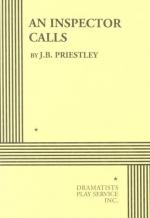|
This section contains 1,776 words (approx. 6 pages at 300 words per page) |

|
How An Inspector Calls Typifies a Murder Mystery
Summary: Examines how writer J.B. Priestley adapts the conventions of a typical murder mystery in `An Inspector Calls'. Examines how his purposes might influence a directors interpretation of the play. Discusses major themes in the play.
The title of the play `An Inspector Calls' gives the expectation that the play is a typical murder mystery, with a body being found and an inspector being called in to investigate, with a twist in the plot at the end when the culprit is revealed. However, this it is no normal murder mystery. The title is, therefore, somewhat misleading and the audience's response to the play is surprising. For example, the way the inspector turns up uninvited, and his manner towards the Birlings is not that of a conventional murder mystery.
The first way in which `An inspector calls' is unlike other murder mysteries is that there is no murder and no discovery of a body. Only through the arrival of the inspector do we learn about the apparent suicide of Eva Smith. Priestley then uses the `whodunit' convention, as the inspector gradually unfolds the circumstances leading...
|
This section contains 1,776 words (approx. 6 pages at 300 words per page) |

|


